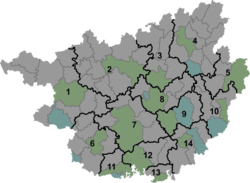Huangjin, Guangxi
 From Wikipedia - Reading time: 6 min
From Wikipedia - Reading time: 6 min
Huangjin
黄金镇 | |||||||
|---|---|---|---|---|---|---|---|
| Coordinates: 24°57′40″N 108°54′50″E / 24.96111°N 108.91389°E | |||||||
| Country | People's Republic of China | ||||||
| Autonomous region | Guangxi | ||||||
| Prefecture-level city | Hechi | ||||||
| Autonomous county | Luocheng Mulao Autonomous County | ||||||
| Incorporated (township) | 1984 | ||||||
| Designated (town) | 1994 | ||||||
| Area | |||||||
• Total | 176.39 km2 (68.10 sq mi) | ||||||
| Population (2019) | |||||||
• Total | 24,940 | ||||||
| • Density | 140/km2 (370/sq mi) | ||||||
| Time zone | UTC+08:00 (China Standard) | ||||||
| Area code | 0778 | ||||||
| Geocode | 546411 | ||||||
| Chinese name | |||||||
| Simplified Chinese | 黄金镇 | ||||||
| Traditional Chinese | 黃金鎮 | ||||||
| Literal meaning | Gold Town | ||||||
| |||||||
Huangjin (Chinese: 黄金镇) is a town in Luocheng Mulao Autonomous County, Guangxi, China.[1] As of the 2019 census it had a population of 24,940 and an area of 176.39-square-kilometre (68.10 sq mi).
Etymology
[edit]The town's name "Huangjin" literally translates to "gold", a name received as the region once produced gold in ancient times.
Administrative division
[edit]As of 2021, the town is divided into one community and seven villages:
- Huangjin Community (黄金社区)
- Simen (寺门村)
- Baoju (宝聚村)
- Zhaibei (寨碑村)
- Zhaidao (寨道村)
- Yihe (义和村)
- Beisheng (北盛村)
- Youdong (友洞村)
History
[edit]Huangjin District (黄金区) was founded in 1925 during the Republic of China.
In 1958, the region split into two communes: Simen People's Commune (寺门人民公社) and Huangjin People's Commune (黄金人民公社), and Simen People's Commune merged into Huangjin People's Commune four years later.[2] Its name was changed to Huangjin Township (黄金乡) in October 1984 and it was upgraded to a town in 1993.[3]
Geography
[edit]It lies at the northeast of Luocheng Mulao Autonomous County, bordering Qiaoshan Township to the west, the town of Dongmen to the south, Baotan Township to the north, and the town of Long'an to the east.
The highest point in the town is Qingming Mountain (青明山) which stands 1,458 metres (4,783 ft) above sea level.
There are two rivers flow through the town: Wuyang River (武阳江) and Huangjin River (黄金大河).
Economy
[edit]The town's economy is based on agriculture and animal husbandry. Significant crops include rice and corn. Sugarcane, peanut, rape are the economic plants of this region.
Demographics
[edit]| Year | Pop. | ±% |
|---|---|---|
| 2011 | 22,458 | — |
| 2019 | 24,940 | +11.1% |
The 2019 census reported the town had a population of 24,940.
References
[edit]- ^ 广西河池有一个黄金镇,黄金矿没有,但是风景非常美,你去过吗. qq.com (in Chinese). 12 August 2021. Retrieved 9 October 2022.
- ^ Wu Jiaquan 2007, p. 43.
- ^ Wu Jiaquan 2007, p. 44.
Bibliography
[edit]- Wu Jiaquan, ed. (2007). 《罗城仫佬族自治县概况》 [General Situation of Luocheng Mulao Autonomous County] (in Chinese). Beijing: Nationalities Publishing House. ISBN 978-7-105-08632-0.
 KSF
KSF